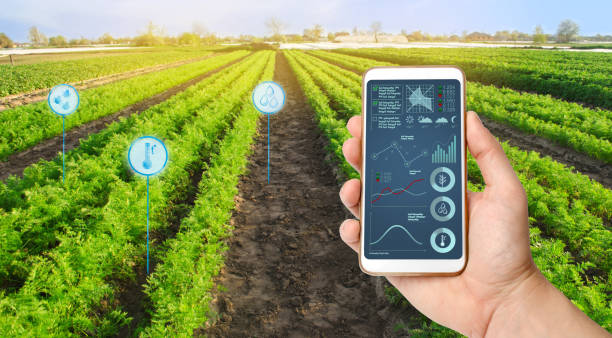Big data is typically considered to be a mix of analytics and technology that collect and analyze new data and use it to aid in making decisions.
The data is collected from a wide range of applications such as mobile app sensors, social networks, drones, and websites, as well as questionnaires and purchases. After data gathering data, big data analytics can then be used to analyze massive amounts of data by the collection and then transform it into actionable strategies.
This technology has been the catalyst for several digital transformations across various industries, including agriculture. It has proved to be an essential element in the development of more services that can lead to a more personalized customer experience and, ultimately, greater profits.
Precision agriculture and big data can provide farmers with data on the changes in weather patterns, rainfall, soil moisture, and other aspects that impact the yield of crops. With this information, farmers can make informed and accurate choices, like which crops to plant for greater work as well as when they should harvest in the end.
There’s plenty of talk regarding big data and the impact it has on industries that haven’t historically been as technologically advanced as other industries, such as agriculture. Let’s look at the ways that big data analytics could change the way we think about farming and farming. Increasing the productivity of the land that is currently being used for agriculture.
What is big data?
Big data refers to information that’s so massive in terms of size and complexity that the more conventional tools for managing data are unable to store it or efficiently process it. A lot of organizations have data silos and are unable to utilize their large data internally.
Big data that is not standardized analysis, harmonization, or standardization is not worth anything. Making big data usable requires time to figure out the best method for every organization. In actual fact, Gartner estimates that 85% of enterprises’ projects to manage their data do not succeed. Also, less than 13% of businesses investing in big data think they are able to generate R&D results. With these numbers, companies are often overwhelmed by trying to find the right strategy.
What exactly is Big Data Analytics?
Big data analytics involves collecting and cleansing massive data sets to assist users in effectively putting their massive data to use. The proper data-based information allows data-driven decision-making.
The potential for applications based on big data is huge; for the agricultural sector, there is the capability to monitor physical items, capture live data in real-time, predict scenarios, and speed up field trials that assist in improving crop management, decrease risks, and guarantee the sustainability of the crop.
Transformation of agriculture through large-scale data analysis
Traditional agricultural practices are considered to be an intuitive area where knowledge is transferred from generation to generation.
But, the urgent issues of the present, like climate change, coupled with the shrinking of arable land, have forced an overhaul in the way practices for farming are assessed and implemented. Climate change and rapid urbanization have wiped out large portions of the farmlands. Within the United States alone, there is a decrease in the total land area of farms from 913 million acres as of 2014 to 895 million acres by 2021.
We are in a meaningful agricultural moment in which we cannot depend on our gut or intuition but instead rely on analytical data derived from Big Data Analytics. To alleviate the growing pressures of demand for food along with climate-related change, politicians and business leaders are seeking help from big data analytics for agriculture.
With the help of GPS along with the web, farms have collected information about their fields for nearly 20 years. In the past decade has, the phrase “big data” taken on an entirely new meaning in the field of agriculture due to the huge amount of data that is now easily captured by modern sensors and equipment.
Data points today can be captured in real-time about different parameters like rain patterns, water use, and fertilizer requirements, as well as crop inputs, health, and yield. With all the information that is available today, researchers, agronomists, and farmers can get a greater understanding of what’s happening on the field level, which can lead to better decisions regarding improvements.
With the growing demand to feed our expanding world population sustainably, the issue of climate change and other environmental problems provide an opportunity to use Big Data Analytics in Agriculture to allow us to increase output and reduce the amount of energy required.
The use of agricultural solutions based on data has been steadily growing. Their value is anticipated to exceed 1.4 billion dollars by 2023. This is a Compound Annual Growth rate (CAGR) that is 12.2 percent from 2020.
Better risk assessment
The world is becoming more uncertain. But when it comes down to the weather, which is a system with a well-known complexity in the past, the trend is in the opposite direction.
Agriculture is already gaining specific information about weather patterns. Improved data tools are unlocking new opportunities, increasing the resilience of farmers to risks posed by weather as well and, at the same, creating new possibilities. Making use of big data in agriculture gives a greater understanding of what the risk is, which will help to reduce the effect of climate-related disasters with an improved plan of action. For example, there are many agricultural regions across the globe where even small changes to the climate could have devastating economic effects.
The price of farming also depends on the conditions. Things like the unpredictability of rain and crop diseases could result in unexpected yield losses and price rises. Big data predictive analysis in the field of agriculture helps farmers reduce the risks associated with shifting weather patterns (drought and heavy rains, floods, drought) and adapt to the changing weather patterns, which allows for a more precise estimation of the yield and output.
Furthermore, new technology for data analytics allows insurance companies to analyze better the risk of weather on crops, allowing farmers to get insurance policies to aid them in overcoming their weather-related obligations, which previously could have been bankrupt.
Agmatix, big data and analytics
Behind the scenes, massive analysis of data in the field of agriculture is causing the digital revolution, which aims to give researchers and agronomists greater insights at the field level and provide farmers with more control over their fields’ production and nutritional needs, as well as improving efficiency and decreasing costs.
Disruptive technology continues to evolve and change, transforming the postmodern agricultural landscape using techniques for precision agriculture. Agmatix provides precision solutions for agriculture that facilitate data-driven decisions of farm practices, research and development, and sustainability issues.
If you’re seeking to extract the full value of your information, contact Agmatixtoday to schedule a demonstration of our services.




